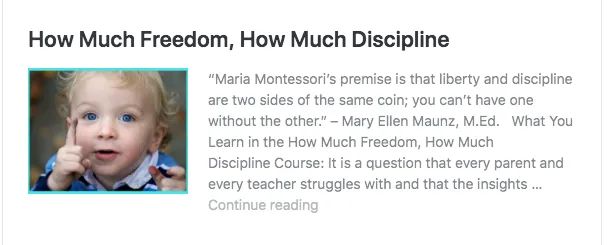The Ten Secrets of Montessori - #7 Freedom of Choice

"He must have absolute freedom of choice, and then he requires nothing but repeated experiences, which will become increasingly marked by interest and serious attention during his acquisition of some desired knowledge."
-Maria Montessori
Secret #7: Freedom of Choice
The child must acquire physical independence by being sufficient unto himself.

Maria Montessori understood that all children, indeed all people, have different strengths and interests. The Montessori Method offers children the “freedom of choice” in order to maximize the learning process through these individual differences. Some people misunderstand “freedom of choice” to mean that children just do whatever they please and/or there is no such thing as discipline in a Montessori classroom. This is actually far from accurate.
In the Montessori classroom, children are given the freedom to choose activities from a carefully prepared environment. This prepared environment is key! Through careful observation of the child, teachers (and parents) can provide the right activities for the child’s development.
The child must acquire physical independence by being sufficient unto himself. Independence of will by choosing alone and freely, independence of thought by working alone and uninterrupted. ~Maria Montessori
Why is freedom of choice so important?
For example, each morning the child comes into the classroom (home or school), and begins the lesson of her choice. She is free to select from prepared lessons on low shelving or other child-accessible locations. She may choose a lesson that she is already familiar with, or she may ask for new lessons. If she chooses a new lesson, the teacher can demonstrate how this new lesson works, or she might observe another child working through the lesson. She may work by herself or with a friend. She may stick with one lesson or (after putting the items away in the proper location) she may move on to something else. All the while, teachers observe the child’s progress, offer help only when needed, and make note of which lessons or activities to introduce next. How Much Freedom? How Much Discipline?
Never help a child with a task at which he feels he can succeed. ~ Maria Montessori
As you can see from the example above, the child experiences free choice, not a free-for-all. But why is freedom of choice so important? Because every child has his or her unique gifts and talents. One child might be quick to learn to read, another is a natural when it comes to numbers. This child is very athletic and coordinated, while that one has a flare for music and art.
 Though they may be similar in age, no two children are the same...
Though they may be similar in age, no two children are the same...

Have you ever noticed that when you’re among a group of children, though they may be similar in age, no two children are the same? They are different heights and weights. There are vastly different activity levels. Some are shy and stay near a parent, while others seem to be fearless risk takers. There are early and late bloomers, visual, auditory and tactile learners, and even big differences depending on external factors such as how much sleep they got last night or how much sugar was (or wasn’t) in their breakfast cereal. What is the balance?
Now, imagine trying to put these very different children together and offer them all the same lesson at the same time. What’s going to happen? You’re likely to have some children that are interested and ready to learn that particular lesson. But what about those for whom the lesson is too difficult or too easy? What about the children who are simply not in that developmental stage right now, but will be a few months from now? This one-size-fits-all technique is almost hit or miss. Maybe the child will benefit from this lesson, and maybe they won’t. How do you know?
We ourselves have lost this deep and vital sensitiveness, and in the presence of children in whom we see it reviving, we feel as if we were watching a mystery being unfolded. It shows itself in the delicate act of free choice, which a teacher untrained in observation can trample on before she even discerns it, much as an elephant tramples the budding flower about to blossom in its path. ~ Maria Montessori
Maria Montessori understood all these learning differences and created an environment for children where they come in each day and choose what they are developmentally ready to work on. When the child chooses his own lessons, he is genuinely interested in learning. And this is how the child learns to follow his own “inner teacher.”
If you would like to learn more about your child’s freedom of choice and following his/her inner teacher, please enjoy this free on-line webinar replay entitled: “Help Your Child Access Their Inner Teacher.”
Help Your Child Access His/Her Inner Teacher
Your child has an inner teacher and so do you! Learn how to help the children you love connect with their very own inner teacher. When children experience the connection to the inner teacher and learn to rely on it, they learn better, they become calmer and more joyful.
Don’t miss this life changing webinar that will help the children in your home or in your school benefit from this powerful message.
This 2-week interactive, online course is a great help for teachers and parents!























